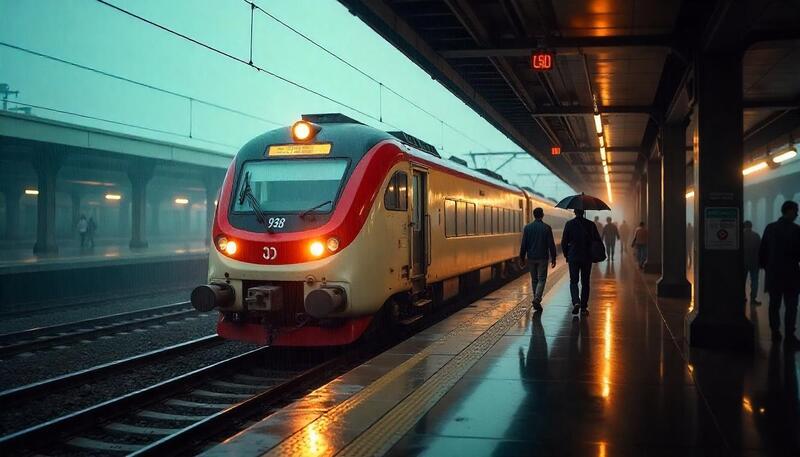≡-India’s Mumbai–Ahmedabad Bullet Train Project Faces Setback as Tunnel Boring Machines Stuck in China Could Lead to Delays in Underground Tunnel Construction: Here’s All You Need to Know – Viral of Today
<> Viral of Today <>
Home » CHINA TRAVEL NEWS » India’s Mumbai–Ahmedabad Bullet Train Project Faces Setback as Tunnel Boring Machines Stuck in China Could Lead to Delays in Underground Tunnel Construction: Here’s All You Need to Know Tuesday, June 24, 2025India’s ambitious Mumbai–Ahmedabad bullet train project has encountered a significant setback, with three critical Tunnel Boring Machines (TBMs) stuck at a Chinese port. These machines are essential for the underground section of the high-speed rail corridor, and their delay could disrupt the project’s timeline. Manufactured in China and ordered from German specialist Herrenknecht, the TBMs were expected to play a pivotal role in the construction of tunnels between key locations such as BKC and Sawli.The construction of India’s first high-speed rail project, the Mumbai–Ahmedabad bullet train corridor, faces potential delays due to a hold-up of crucial equipment at a Chinese port. Three massive Tunnel Boring Machines (TBMs), which are vital for building the underground section of this ambitious project, are currently stuck in Guangzhou, China. While the machines were ordered from the German tunnelling specialist Herrenknecht, they were manufactured at its facility in China. The delay has raised significant concerns and could impact the project’s timeline.The Hold-Up and Its Impact on the ProjectThe TBMs were scheduled to be deployed for tunneling work along the Mumbai-Ahmedabad corridor. Two of the machines are expected to arrive in India by October 2024, while the third was supposed to be delivered earlier this year. However, all three TBMs have not received clearance from Chinese authorities. The lack of any official explanation for the hold-up has triggered diplomatic concerns and sent the Indian government into action.The Indian Railway Ministry has escalated the issue by involving the Ministry of External Affairs, utilizing diplomatic channels to expedite the release of the equipment. In addition to the TBMs, other essential infrastructure components for the project are also stuck at the port, further complicating the situation. The National High-Speed Rail Corporation Ltd (NHSRCL), the development agency for the project, had planned to use the TBMs for tunneling between BKC (Bandra Kurla Complex) and Sawli (Ghansoli).Potential Consequences for the Underground Tunnel WorkA prolonged delay in the deployment of the TBMs could have serious consequences for the underground section of the bullet train project, particularly for the 21-kilometer stretch from BKC to Shilphata. This section of the tunnel is critical to the overall project, and a portion of it includes a challenging 7-kilometer subsea tunnel beneath Thane Creek. Any delay in the tunneling process could push back the completion of this important underground stretch, which would, in turn, disrupt the entire timeline of the project.Although officials at NHSRCL have declined to comment on the matter, sources within the organization suggest that the overall deadline for the Mumbai–Ahmedabad bullet train remains unchanged, at least for the time being. However, the uncertainty surrounding the availability of the TBMs means that there is still a level of unpredictability in the project’s progress.The Role of the TBMs in the Project’s DevelopmentThe TBMs ordered for the bullet train project are not ordinary machines; they are the largest of their kind ever built for Indian soil. One of the TBMs has a cutter head diameter of 13.56 meters, which is significantly larger than the typical metro TBMs that usually measure between 6.45 and 6.68 meters in diameter. For comparison, the 12.19-meter ‘Mavala’ TBM used in Mumbai’s coastal road project is smaller in size. These massive machines are crucial for the tunneling work, especially in complex geological conditions, and the delay in their deployment could hamper progress significantly.Manufactured at Herrenknecht’s Guangzhou facility, these TBMs come equipped with a Mixshield configuration, designed specifically to navigate the varied geological conditions of the Mumbai–Ahmedabad corridor with precision. The TBMs will be used by Afcons Infrastructure Ltd, which has been awarded the contract for underground Package C-2. This package involves a 20.377-kilometer stretch from BKC to Shilphata and includes the subsea tunnel under Thane Creek. The section is considered one of the most challenging parts of the project, given the complex topography and the deep underwater tunnel required.Project Schedule and Tunneling ContractsAfcons Infrastructure Ltd won the Rs 6,397 crore contract for the underground portion of the Mumbai–Ahmedabad bullet train corridor in June 2023. The company has a completion timeline of 5.17 years, with preparatory work already underway.In June 2023, Afcons Infrastructure Ltd secured the Rs 6,397 crore contract for the underground section of the Mumbai–Ahmedabad bullet train corridor. The company has set a completion target of 5.17 years, with initial groundwork already underway. As part of the preparatory phase, Afcons is constructing three vertical shafts: one at BKC, reaching a depth of 36 meters, another at Vikhroli at 56 meters, and a third at Sawli at 39 meters. These shafts will serve as the primary launch and retrieval points for the Tunnel Boring Machines (TBMs). In addition, an inclined shaft at Ghansoli, 42 meters deep, and a tunnel portal at Shilphata are under development to facilitate 5 kilometers of tunneling using the New Austrian Tunneling Method (NATM). These shafts will serve as the launch and retrieval points for the TBMs. Additionally, an inclined shaft at Ghansoli (42 meters) and a tunnel portal at Shilphata are being developed to support 5 kilometers of tunneling using the New Austrian Tunneling Method (NATM).The tunneling process for this underground section will see depths ranging from 25 to 65 meters below ground level, with the deepest point being 114 meters beneath Parsik Hill near Shilphata. This ambitious project requires precision, and any delay in the TBM delivery could compromise the entire construction timeline.Diplomatic and Political ChallengesThe ongoing delay in the TBM delivery is also exacerbated by the broader political and diplomatic context. Since the Galwan clash between India and China in June 2020, India has taken a more cautious approach towards Chinese investments and contracts. The clash, which led to a significant deterioration in relations between the two countries, has led India to impose stricter scrutiny on Chinese-origin products and contracts.For example, the Mumbai Metropolitan Region Development Authority (MMRDA) scrapped bids for the Mumbai Monorail project involving two Chinese firms after the Galwan clash. Similarly, Maharashtra’s state government put on hold several major Memorandums of Understanding (MoUs) with Chinese companies, valued at over Rs 5,000 crore. While the TBMs for the Mumbai metro and coastal road projects came from China before the Galwan clash, the current political environment has created additional hurdles for the bullet train project.Collaborative Efforts to Resolve the IssueDespite the challenges, the NHSRCL, Herrenknecht, Afcons Infrastructure Ltd, and the relevant ministries are reportedly working closely together to resolve the current impasse. Diplomatic channels have been activated to push for the clearance of the equipment, and all parties are optimistic that the situation will be resolved soon. However, the delay in the delivery of the TBMs has served as a reminder of the challenges that large-scale infrastructure projects face when international diplomacy, political relations, and logistics collide.ConclusionThe Mumbai–Ahmedabad bullet train project is a crucial milestone for India’s infrastructure and economic growth. However, the ongoing delay in the arrival of the TBMs has raised significant concerns about the project’s timeline. While efforts are underway to resolve the situation, the impasse has highlighted the complex intersection of infrastructure development, international trade, and geopolitical dynamics. As India continues to strive for modernization in its transportation network, resolving these kinds of delays will be critical for the success of ambitious projects like the Mumbai–Ahmedabad bullet train.Tags: ahmedabad, bullet train, china, China Travel News, Guangzhou, high-speed rail project, India, India travel news, mumbai, Railway News of India, Tourism news, Travel News
This information will surprise you!
See also
- Read until the end to discover everything.
- Important information you need to know.
- Interesting facts and helpful tips.
Conclusion
Did you enjoy the news? Keep following us daily!













